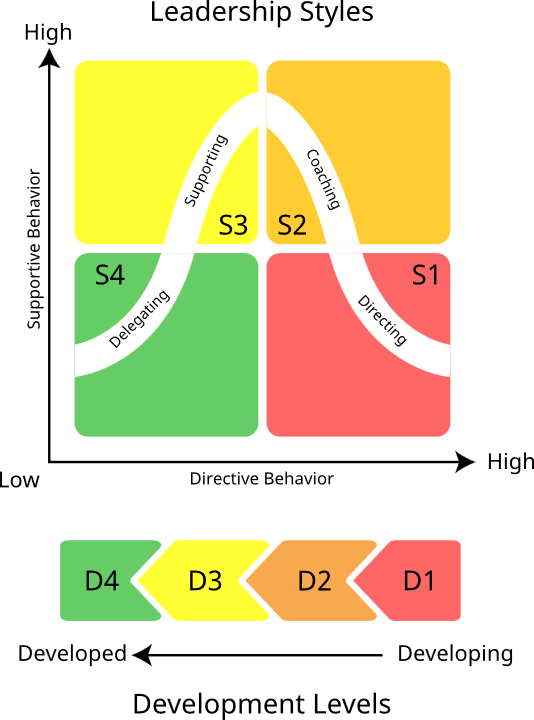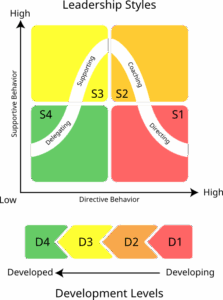The Challenge of Leadership in Child Care
Home » Leadership » The Challenge of Leadership in Child Care

As an owner-operator or administrator of a child care business, you wear many hats. You manage finances, human resources,  education, and marketing. You ensure safety, customer service, and maintenance. Some days, you may even step into roles like educator, cook, bus driver, therapist, mentor, or conflict resolution specialist.
education, and marketing. You ensure safety, customer service, and maintenance. Some days, you may even step into roles like educator, cook, bus driver, therapist, mentor, or conflict resolution specialist.
With such a broad range of responsibilities and a diverse team, a one-size-fits-all leadership approach isn’t effective. To create a thriving child care business, you need a leadership style that adapts to different situations and empowers your team. This is where Situational Leadership comes in.
What is Situational Leadership?
As a former administrator overseeing multiple child care centers, I constantly sought the best ways to support center directors at different levels of readiness. In turn, they needed to do the same for their staff. It wasn’t until I discovered Situational Leadership that I realized effective leadership isn’t about a single approach; it’s about adapting to meet the needs of your team members.
Situational Leadership suggests that successful leaders adjust their style based on their staff’s competence and commitment levels. By recognizing these factors, you can provide the right level of guidance and support to help your team succeed.
Key Components of Situational Leadership?
1. Leadership Style

2. Readiness Levels

Common Leadership Challenges and How Situational Leadership Helps
- High Staff Turnover
Challenge: Frequent staff changes make it difficult to maintain consistency and quality care.
Solution:
- Use Telling (Directing) for new hires by providing clear expectations, structured training, and close supervision.
- It is important to remember that Telling (Directing) is not a one-time event with new hires. Frequent Selling (Coaching) is also necessary to ensure they clearly understand how to perform their job responsibilities.
- Use Supporting (Participating) for experienced staff by involving them in decision-making to increase job satisfaction and retention.
- Staff Burnout and Low Morale
Challenge: Child care work is demanding and often leads to emotional exhaustion.
Solution:
- Recognize burnout and use Supporting to reduce stress and provide emotional support.
- Delegate tasks strategically to balance workloads and prevent burnout.
- Inconsistent Classroom Management
Challenge: Some staff members struggle with behavior management in their classroom.
Solution:
- Use Coaching by providing feedback and modeling best practices in real-time.
- Delegate an experienced staff member to mentor those who need extra guidance.
- Balancing Administrative and Hands-on Leadership
Challenge: Directors juggle paperwork, parent communication, and staff supervision.
Solution:
- Delegate responsibilities to trusted team members (e.g., lead teachers handle curriculum planning).
- Support staff when needed but avoid micromanaging.
- Building Trust with Parents
Challenge: Parents want constant reassurance and proof that their children are safe and well cared for.
Solution:
- Use Telling (Directing) to train new staff in professional communication. Remember also to incorporate Selling (Coaching) as a way to help new staff build both confidence and competence as they build relationships with the parents of the children in their classroom.
- Delegate parent-teacher interactions to experienced staff to foster strong relationships.
Why Situational Leadership Belongs in Your Child Care Business
- Improves communication by encouraging open dialogue between leaders and staff.
- Increases productivity by ensuring employees receive the right level of direction and support.
- Builds stronger relationships as employees feel valued when leadership adapts to their needs.
- Enhances decision-making by helping leaders assess situations accurately before taking action.
- Prevents micromanagement or undermanagement, both of which can hinder performance.
- Encourages employee development by gradually building team members’ confidence and competence.
Final Thoughts
By implementing Situational Leadership in your child care business, you can create a positive, thriving work environment where staff feel supported and empowered. Take a moment to assess your leadership approach; adjusting it to your team’s needs can make all the difference in your business’ success!
Cindy Lehnhoff
